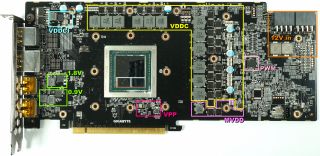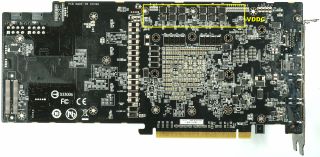Gigabyte Radeon RX Vega 64 Gaming OC 8G Review
Why you can trust Tom's Hardware
Board & Power Supply
Board Layout
As with its Radeon RX Vega 56 Gaming OC 8GB, Gigabyte again deviates significantly from AMD's reference board. Unfortunately, this also means that the design is incompatible with most existing full-cover water coolers. Even Raijintek's popular Morpheus is not an option. While Gigabyte implements six power phases with doubling, resulting in 12 voltage converters for the VDDC, and one phase for the memory (MVDD), just like AMD, the way those elements are oriented is bound to cause issues for third-party coolers.
The sources of other auxiliary voltages are also visible in our layout diagram.

A look at the board's back side reveals that half of the most heavily-used low-side MOSFETs are relocated there. So, it's safe to assume that ~30% of all voltage converter losses (and associated heat) occur on the back of the card. Naturally, then, it isn't enough to only dissipate heat from the board's front. Cooling is now required on both sides.

Gigabyte relies on a total of two eight-pin auxiliary power connectors to complement the 16-lane PCIe slot. According to our measurements, that slot delivers a maximum of ~25W, so those two connectors make up the difference.
A once-over of the PCB suggests that, once again, Gigabyte omitted many components found on its pre-production sample. The list of missing features begins with a Holtek microprocessor for RGB controls and ends with a second BIOS IC, which we miss a lot more. In the end, what remains is a cut-down version of what started as a much more ambitious project.
GPU Power Supply (VDDC)
As with AMD's reference design, the focus is on International Rectifier's IR35217, a dual-output multi-phase controller that provides six phases for the GPU and an additional phase for the memory. But again, there are 12 regulator circuits, not just six. This is a result of doubling, allowing the load from each phase to be distributed between two regulator circuits.


Six IR3598 interleaved MOSFET drivers, three on the front and three on the back, are responsible for this doubling. The actual voltage conversion for each of the 12 regulator circuits is handled by one Alpha & Omega Semiconductor AON6594 on the high side and two AON6360s in parallel on the low side. This is an inexpensive but acceptable choice of components, especially since the parallel arrangement also means that thermal hot-spots are distributed more evenly.


Gigabyte relies on Magic chokes for its VDDC and MVDD. With only 10nH for the VDCC, however, these encapsulated ferrite-core coils are rather small.
The one MVDD phase's coils are more average, having an inductance of 22nH. However, in other cards, we've even seen 33nH chokes.


Memory Power Supply (MVDD)
As mentioned, the memory's power is controlled by International Rectifier's IR35217 as well. One phase is fully sufficient for this card, as its HBM2 is less demanding. Similar to the VDDC, one AON6594 on the high side and two AON6360s in parallel on the low side are used.


Additional Voltage Converters
Creating the VDDCI isn’t a very difficult task. But it's an important one since this regulates the transition between the internal GPU and memory signal levels. It’s essentially the I/O bus voltage between the GPU and memory. As such, two constant sources of 1.8V and 0.9V are supplied.


Underneath the GPU, there’s an Anpec APL5620 low drop-out linear regulator, which provides the very low voltage for the phase locked loop (PLL) area.


Everything else is standard fare. Only the single BIOS chip stands out. Gigabyte naturally leaves off the switch you'd use to toggle between BIOSes on a dual-firmware board, although there is a designated space for it on the PCB.


A 68nH ferrite-core coil helps to block peaks and any other potential by-products of the power supply.
MORE: Best Graphics Cards
MORE: Desktop GPU Performance Hierarchy Table
MORE: All Graphics Content
Stay on the Cutting Edge
Join the experts who read Tom's Hardware for the inside track on enthusiast PC tech news — and have for over 25 years. We'll send breaking news and in-depth reviews of CPUs, GPUs, AI, maker hardware and more straight to your inbox.
-
g-unit1111 I really wish we could buy these. I'd love to get a Vega 56. This GPU shortage is getting absolutely stupid.Reply -
FormatC I personally hate this stupid mining. A waste of ressources, only to feed a big bubble.Reply
And to look forward:
No VGA available means no sales of CPU, mainboards, memory etc.
The kiddies will buy consoles... Totally bad for the PC market and periphery.
-
barryv88 Again, Toms is very tight lipped about these Vega cards consistently outperforming their competitors. Hardly anything mentioned about those gaming benchmarks and the fact that the V64 eats the 1080 especially at 2560 res. AND you get a great mining card. And a $200 cheaper monitor (instead of a Gsync comparable one) thanx to Freesync. I'm counting quite alot of wins here. If only the miners didn't spoil the party!Reply -
FormatC Reply
http://www.tomshardware.com/reviews/best-nvidia-geforce-gtx-1080-graphics-cards,4725.html20634804 said:Good power analysis. I wish there were comparisons against the 1080 though.
I made such a thing long time ago. Simply pick a card of your choice and compare it. The 1080 is in a few months old iron ;)
No hash rate benchmarks? Disappointed:(
It is a gaming card, not just another card to feed the mining bubble. The current market situation is the result of all this mining shit. Greed eats brain - not with me. Please don't ask me, how I got these both samples. You see any other reviews of this GB cards? :)
Hardly anything mentioned about those gaming benchmarks
Of course, I could have added a performance/watt curve as well. It has all some pros and cons. Sometimes it's just better to keep quiet. Everyone can read, what he prefer. :)
-
pepar0 Personally, I think the tech/gaming media should STOP reviewing graphics cards that cannot be purchased. Nor couldn't be afforded if they could be found. This is not out of wanting to punish the GPU makers, but is rather a practical and principals matter. Plus it might cause GPU makes to rethink their positions; gamers will be here if digital currencies evolve to where mining is not needed.Reply -
g-unit1111 Reply20634712 said:Again, Toms is very tight lipped about these Vega cards consistently outperforming their competitors. Hardly anything mentioned about those gaming benchmarks and the fact that the V64 eats the 1080 especially at 2560 res. AND you get a great mining card. And a $200 cheaper monitor (instead of a Gsync comparable one) thanx to Freesync. I'm counting quite alot of wins here. If only the miners didn't spoil the party!
I'd *LOVE* to buy a Vega 56 or Vega 64 especially to compare with my 1080, and the Vega platform is pretty solid. The GPU makers really need to start taking steps to end this madness. The GPU shortage is getting to be ridiculously stupid on every level.